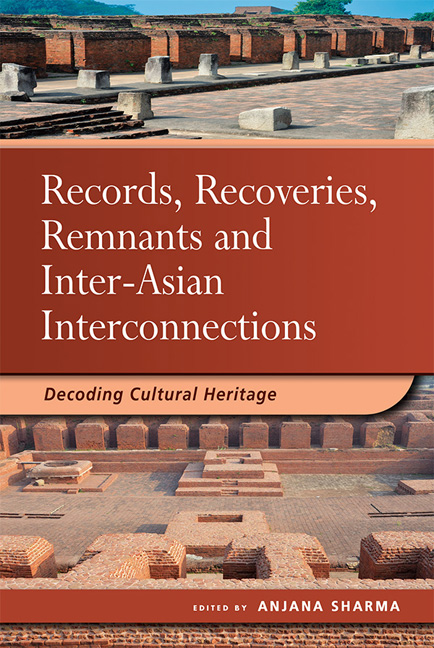Book contents
- Frontmatter
- Dedication
- Contents
- Contributors
- Acknowledgements
- 1 Introduction: Records, Recoveries, Remnants and Inter-Asian Interconnections — Decoding Cultural Heritage
- 2 Negotiating Place and Heritage: Creating Nalanda University
- 3 India, Magadha, Nalanda: Ecology and a Premodern World System
- 4 Collecting the Region: Configuring Bihar in the Space of Museums
- 5 Heritage Preservation in the Gaya Region
- 6 Setting the “Records” Straight: Textual Sources on Nālandā and Their Historical Value
- 7 “Central India Is What Is Called the Middle Kingdom”
- 8 The Object | The Tree: Emissaries of Buddhist Ground
- 9 Tracing Transregional Networks and Connections Across the Indic Manuscript Cultures of Nusantara (AD 1400–1600)
- 10 Seeking a Sufi Heritage in the Deccan
- 11 Archaeological Remains at Nalanda: A Spatial Comparison of Nineteenth Century Observations and the Protected World Heritage Site
- 12 A Heritage Gem Sits in the Heart of a City, Unacknowledged, Incognito: The Case for Recognizing Kolkata Chinatown as a Historic Urban Landscape
- Index
- Miscellaneous Endmatter
5 - Heritage Preservation in the Gaya Region
Published online by Cambridge University Press: 04 July 2018
- Frontmatter
- Dedication
- Contents
- Contributors
- Acknowledgements
- 1 Introduction: Records, Recoveries, Remnants and Inter-Asian Interconnections — Decoding Cultural Heritage
- 2 Negotiating Place and Heritage: Creating Nalanda University
- 3 India, Magadha, Nalanda: Ecology and a Premodern World System
- 4 Collecting the Region: Configuring Bihar in the Space of Museums
- 5 Heritage Preservation in the Gaya Region
- 6 Setting the “Records” Straight: Textual Sources on Nālandā and Their Historical Value
- 7 “Central India Is What Is Called the Middle Kingdom”
- 8 The Object | The Tree: Emissaries of Buddhist Ground
- 9 Tracing Transregional Networks and Connections Across the Indic Manuscript Cultures of Nusantara (AD 1400–1600)
- 10 Seeking a Sufi Heritage in the Deccan
- 11 Archaeological Remains at Nalanda: A Spatial Comparison of Nineteenth Century Observations and the Protected World Heritage Site
- 12 A Heritage Gem Sits in the Heart of a City, Unacknowledged, Incognito: The Case for Recognizing Kolkata Chinatown as a Historic Urban Landscape
- Index
- Miscellaneous Endmatter
Summary
Being the home of two prominent UNESCO World Heritage sites of Bodhgaya and Nalanda, South Bihar region has a rich historical past. The region also witnessed the emergence of important urban and political centres of Rajgir and Pataliputra in ancient India. In early medieval India, the region was known as the centre of Buddhism because of the prominent Buddhist monasteries and their religious and political influence over the region. In this period, there also emerged a distinct tradition of stone and metal sculptural production, enriching the material assemblage of the region. The expansive material assemblage of this period can be encountered in almost every district of the South Bihar region including the Gaya district. Though the historical and religious prominence of this district is evident at the sites of Bodhgaya and Gaya, the district also has several smaller sites and villages with impressive material remains that have been documented in the last two hundred years and will be examined in this chapter.
Because of the historical and sacred importance of Gaya and Bodhgaya, the district began to attract scholarly attention from the nineteenth century onwards. This is illustrated by the surveys of numerous colonial surveyors and archaeologists. Colonial surveys began with Francis Buchanan- Hamilton, who surveyed this district in 1811–12. Along with the sites of Bodhgaya and Gaya, he also surveyed several villages that contained historical remains or older temples and shrines. Following on from this initial foray, in the second half of the nineteenth century, Alexander Cunningham, the first director-general of the Archaeological Survey of India (ASI, hereafter), and J.D. Beglar also explored the district and documented several villages of historic importance and their significant remains. In the last ten years, new surveys have been conducted, which resulted in the documentation of more than 350 sites with historical remains including mounds, sculptures, inscriptions, architectural elements, and shrines/temples from the ancient and early medieval periods. All of these documentations have revealed resituated contexts of several early medieval images and temples, which indicate a complex and disparate history of the district.
Colonial surveys, conducted in the second half of the nineteenth century, led to the movement of objects, images, and architectural materials into newly built colonial museums.
- Type
- Chapter
- Information
- Records, Recoveries, Remnants and Inter-Asian InterconnectionsDecoding Cultural Heritage, pp. 86 - 104Publisher: ISEAS–Yusof Ishak InstitutePrint publication year: 2018



